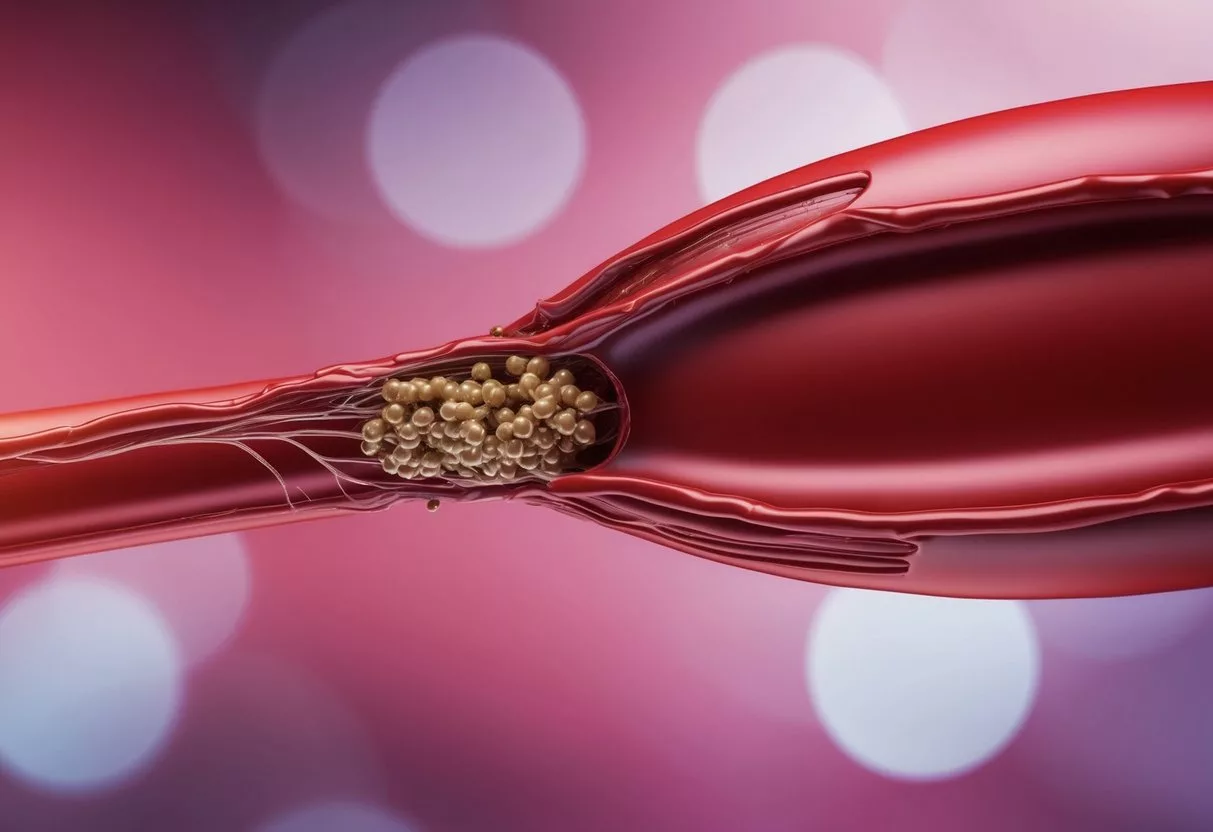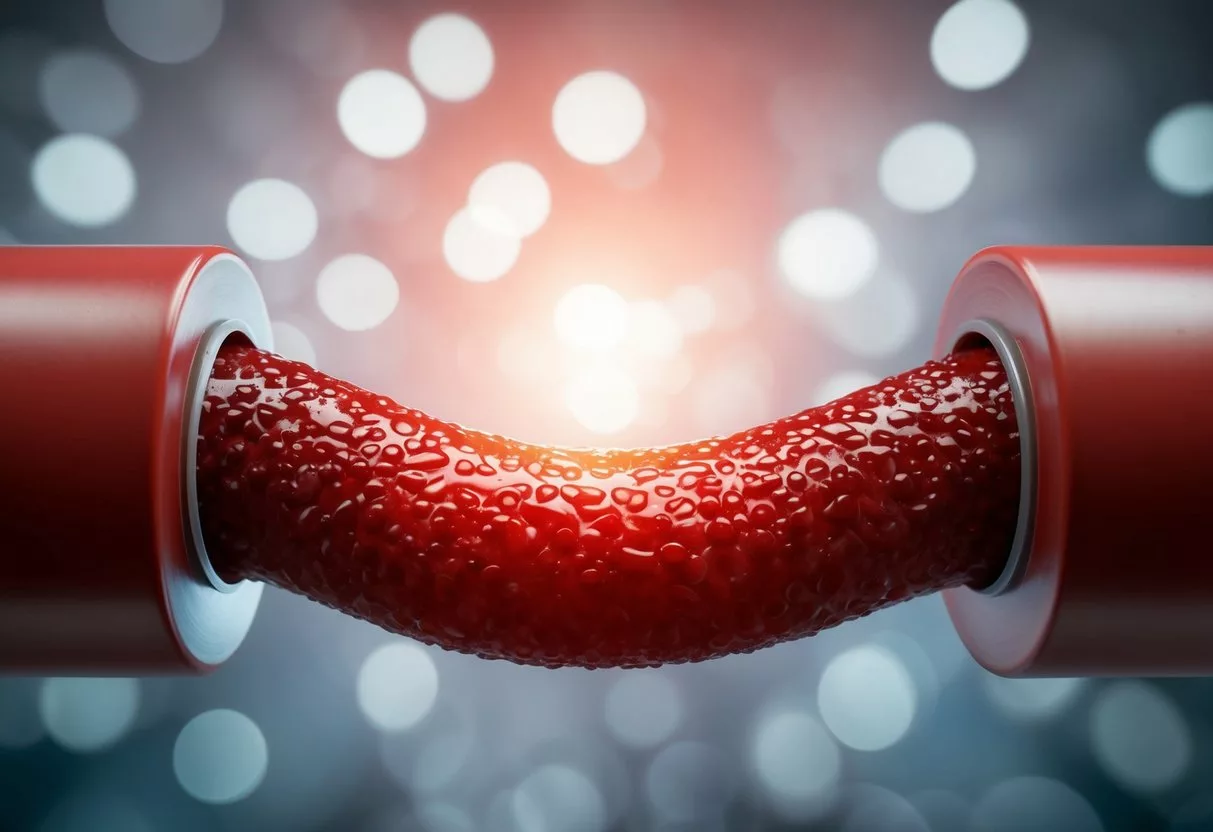High cholesterol is a silent condition that can have grave consequences for your health. It occurs when there’s too much fat in your blood, which can build up in your arteries over time. High cholesterol can increase your risk of heart disease by causing fatty deposits to form in your blood vessels.

Many people don’t realize they have high cholesterol because it doesn’t cause obvious symptoms. The only way to know for sure is through a blood test. If left untreated, high cholesterol can lead to atherosclerosis, a condition where arteries become narrow and hardened.
Fortunately, high cholesterol can often be managed through lifestyle changes and medication. Eating a healthy diet, exercising regularly, and quitting smoking can all help lower cholesterol levels. For some people, doctors may also prescribe cholesterol-lowering drugs to reduce their risk of heart problems.
Key Takeaways
- High cholesterol can cause fatty deposits in arteries, increasing heart disease risk.
- The condition has no symptoms and can only be detected through blood tests.
- Lifestyle changes and medication can help manage high cholesterol levels.
Fundamentals of Cholesterol and Lipoproteins

Cholesterol plays a key role in the body. It moves through the blood in different types of particles called lipoproteins. These particles help keep cholesterol levels in check.
The Basics of Cholesterol
Cholesterol is a waxy substance found in blood. The body needs it to build healthy cells. The liver makes most of the cholesterol in the body. Some also comes from food.
Cholesterol helps make:
- Cell membranes
- Hormones
- Bile for digestion
Too much cholesterol can be bad. It can build up in blood vessels. This makes it hard for blood to flow freely.
Types of Lipoproteins
Lipoproteins carry cholesterol in the blood. There are two main types:
- Low-density lipoprotein (LDL): Often called “bad” cholesterol. It can build up in arteries.
- High-density lipoprotein (HDL): Known as “good” cholesterol. It helps remove other forms of cholesterol from the blood.
Lipoproteins are made of fat and protein. They move cholesterol and other fats through the body. The balance of these lipoproteins affects heart health.
Functions and Importance of Cholesterol
Cholesterol is vital for many body functions:
- It helps make cell membranes. Cholesterol is a key component of cell membranes, helping to maintain their fluidity and structural integrity. It is essential for the proper functioning of cells.
- It’s needed for hormone production. Cholesterol is a precursor for the synthesis of various hormones, including sex hormones (estrogen and testosterone) and corticosteroids (like cortisol). These hormones are vital for various bodily functions, including growth, development, and metabolism.
- It’s needed to produce vitamin D, Cholesterol in the skin is converted into vitamin D when exposed to sunlight. Vitamin D is very important for bone health and immune function.
- It’s used to produce bile. Cholesterol is converted into bile acids in the liver, which are then stored in the gallbladder. Bile acids are essential for the digestion and absorption of fats and fat-soluble vitamins.
- Brain function. Cholesterol is important for brain function and development. It is a component of myelin, the fatty substance that surrounds nerve fibers, facilitating the transmission of nerve impulses.
- Immune system function. Cholesterol is involved in the functioning of the immune system. For example, it is necessary for the proper functioning of natural killer cells, which are crucial for fighting infections and cancer.
The liver makes bile from cholesterol. Bile helps digest fats. Cholesterol also helps nerves work right.
But high levels can be harmful. They can lead to fatty deposits in blood vessels. This raises the risk of heart disease. Keeping cholesterol levels in check is key for good health.
How High Cholesterol Affects the Body

High cholesterol can harm many parts of the body. It mainly affects the heart and blood vessels, but can also impact other organs. The effects can be serious and long-lasting if not treated.
Impact on the Cardiovascular System
High cholesterol levels cause fatty deposits to build up in the blood vessels. This narrows the arteries and reduces blood flow. The heart has to work harder to pump blood through these narrow passages. Over time, this extra strain can weaken the heart muscle.
As cholesterol builds up, it forms plaque on artery walls. This process is called atherosclerosis. Plaque makes arteries stiff and less flexible. It can also break off and form clots that block blood flow completely.
The coronary arteries that feed the heart are especially at risk. When these get blocked, it can lead to chest pain or a heart attack.
Connection to Heart Attacks and Strokes
High cholesterol raises the risk of heart attacks and strokes. When plaque blocks a coronary artery, part of the heart muscle dies if not treated promptly and aggressively. This is a heart attack. If a clot blocks blood flow to the brain, it causes a stroke.
LDL cholesterol is the main culprit. It’s often called “bad” cholesterol because it contributes to plaque buildup. HDL cholesterol helps remove LDL from the arteries, so it’s known as “good” cholesterol.
People with high cholesterol often have no symptoms until a heart attack or stroke occurs. Regular check-ups can catch high levels before damage happens.
However, please keep in mind that the terms “bad cholesterol” and “good cholesterol” are somewhat outdated and oversimplify the complex roles of different types of cholesterol in the body. Recent scientific advances have provided a more nuanced understanding:
- LDL (Low-Density Lipoprotein) Cholesterol: Traditionally referred to as “bad cholesterol,” LDL carries cholesterol from the liver to peripheral tissues. High levels of LDL cholesterol are associated with an increased risk of cardiovascular disease. However, not all LDL particles are equally harmful. Some LDL particles are larger and less atherogenic, while smaller, denser LDL particles are more harmful.
- HDL (High-Density Lipoprotein) Cholesterol: Often called “good cholesterol,” HDL transports cholesterol from peripheral tissues back to the liver for excretion. High levels of HDL cholesterol are generally associated with a lower risk of cardiovascular disease. However, recent studies have shown that the functionality of HDL, rather than just its concentration, is more important. Some individuals with high HDL levels can still have dysfunctional HDL, which does not provide the expected protective benefits.
- Other Lipoproteins: Other lipoproteins, such as very-low-density lipoproteins (VLDL) and intermediate-density lipoproteins (IDL), also play roles in cholesterol transport and cardiovascular risk.
Given these advances, it is more accurate to discuss cholesterol in terms of the specific lipoproteins and their functions rather than using the simplistic “good” and “bad” labels. This approach acknowledges the complexity of cholesterol metabolism and the need for a more detailed understanding of its role in health and disease.
Influence on Other Body Systems
While the heart and blood vessels are most affected, high cholesterol impacts other parts of the body too. It can cause problems in the:
- Brain: Poor blood flow can lead to memory loss and confusion
- Legs: Reduced circulation can cause pain and numbness
- Eyes: Tiny blockages can damage vision
- Digestive system: Gallstones may form from excess cholesterol
High cholesterol can also affect hormone production. This is because some hormones are made from cholesterol. Too much can disrupt the balance.
Peripheral artery disease is another risk. This happens when arteries in the arms and legs get blocked. It can cause pain and difficulty walking.
Causes and Risk Factors for High Cholesterol

High cholesterol can result from various factors, including diet, lifestyle, genetics, and certain health conditions. These elements can increase the amount of cholesterol in the blood, leading to potential health risks.
Dietary and Lifestyle Influences
A diet high in saturated and trans fats can raise cholesterol levels. Foods like red meat, full-fat dairy, and fried foods are common culprits. Lack of exercise and being overweight also contribute to high cholesterol.
Smoking damages blood vessel walls, making them more prone to accumulate fatty deposits. Excessive alcohol consumption can increase triglycerides and cholesterol levels.
Lifestyle changes that can help:
- Eating more fruits, vegetables, and whole grains
- Choosing lean proteins and low-fat dairy
- Regular exercise (30 minutes a day, 5 days a week)
- Quitting smoking
- Limiting alcohol intake
Genetic Factors and Family History
Some people have a genetic predisposition to high cholesterol. This condition, called familial hypercholesterolemia, causes very high LDL levels from birth.
Family history plays a role too. If a close relative has high cholesterol or heart disease, a person’s risk increases.
Genes can affect:
- How the body processes cholesterol
- How efficiently LDL receptors work
- The rate of cholesterol production in the liver
Other Health Conditions Contributing to High Cholesterol
Several medical conditions can lead to high cholesterol:
- Diabetes: Can lower HDL (good) cholesterol and raise LDL (bad) cholesterol.
- Hypothyroidism: An underactive thyroid slows the body’s ability to break down and remove LDL cholesterol.
- Kidney disease: Can alter how the body processes cholesterol.
- Obesity: Excess weight lowers HDL cholesterol and raises LDL cholesterol.
High blood pressure and lupus may also affect cholesterol levels. Some medications, like steroids, can increase cholesterol as a side effect.
Identifying High Cholesterol

High cholesterol has no obvious symptoms. Finding out if you have it requires a blood test. Regular screening is key for early detection and treatment.
Symptoms of High Cholesterol
High cholesterol itself doesn’t cause noticeable symptoms. You might feel perfectly healthy even with high levels. This is why it’s often called a “silent” condition.
In rare cases, very high cholesterol can cause visible signs. Some people may develop yellowish growths on their skin called xanthomas. These can appear on the eyelids, hands, or other parts of the body.
Without treatment, high cholesterol can lead to serious health problems. It increases the risk of heart disease and stroke. But these complications develop over time and aren’t direct symptoms of high cholesterol.
Screening and Diagnostic Tests
The main way to detect high cholesterol is through a blood test called a lipid panel. This test measures different types of fats in the blood.
A lipid panel typically includes:
- Total cholesterol
- LDL (low-density lipoprotein) cholesterol
- HDL (high-density lipoprotein) cholesterol
- Triglycerides
For accurate results, fasting for 9-12 hours before the test is usually required. Only water is allowed during this time.
The National Heart, Lung, and Blood Institute recommends first cholesterol screening between ages 9 and 11. After that, it should be repeated every five years. Adults may need more frequent testing based on their risk factors.
Cholesterol Test Results Interpretation
Cholesterol levels are measured in milligrams per deciliter (mg/dL) of blood. Here’s what the numbers mean:
Total Cholesterol:
- Below 200 mg/dL: Desirable
- 200-239 mg/dL: Borderline high
- 240 mg/dL and above: High
LDL Cholesterol:
- Below 100 mg/dL: Optimal
- 100-129 mg/dL: Near optimal
- 130-159 mg/dL: Borderline high
- 160-189 mg/dL: High
- 190 mg/dL and above: Very high
HDL Cholesterol:
- Below 40 mg/dL (men) or 50 mg/dL (women): Low
- 60 mg/dL and above: High (protective against heart disease)
Triglycerides:
- Below 150 mg/dL: Normal
- 150-199 mg/dL: Borderline high
- 200-499 mg/dL: High
- 500 mg/dL and above: Very high
A doctor will consider these results along with other risk factors to determine if treatment is needed.
Treatment Options for High Cholesterol

High cholesterol can be managed through medications and lifestyle changes. Several effective options exist to lower cholesterol levels and reduce heart disease risk.
Medications Used to Lower Cholesterol
Statins are the main drugs used to treat high cholesterol. They work by blocking a substance the body needs to make cholesterol. Statins can lower LDL cholesterol by 20% to 55%.
Other medication types include:
- Bile acid sequestrants
- Cholesterol absorption inhibitors
- PCSK9 inhibitors
- Fibrates
- Niacin
Doctors may prescribe one drug or a mix of different types. The choice depends on a person’s cholesterol levels, health issues, and risk factors.
Most Common Side Effects of Cholesterol-Lowering Medicines
Statins can cause muscle pain in some people. This is usually mild but can be severe in rare cases. Other possible side effects include:
- Liver damage
- Increased blood sugar
- Memory problems
- Digestive issues
Bile acid sequestrants may cause stomach pain and constipation. Niacin can lead to flushing and liver problems.
It’s key to tell the doctor about any side effects. They can adjust the dose or try a different drug if needed.
Lifestyle Modifications and Diet
A healthy lifestyle is fundamental for managing cholesterol. Key changes include:
Diet: Eat more fruits, veggies, and whole grains. Choose lean proteins and low-fat dairy. Limit saturated and trans fats.
Exercise: Aim for at least 150 minutes of moderate activity per week. This can lower LDL and raise HDL cholesterol.
Weight: Losing extra pounds can improve cholesterol levels.
Quit smoking: This helps raise HDL cholesterol.
Limit alcohol: Too much can raise triglycerides and blood pressure.
Monitoring and Ongoing Management
Regular check-ups are vital to track cholesterol levels. Blood tests measure total, LDL, and HDL cholesterol, plus triglycerides.
Doctors may adjust treatment based on test results. They also check for medication side effects.
Some people need more frequent testing, like those with heart disease or diabetes. Others may test yearly if levels are stable.
It’s key to stick to the treatment plan. This means taking meds as prescribed and keeping up with lifestyle changes. Good management can greatly cut the risk of heart attacks and strokes.
Prevention Strategies for Maintaining Healthy Cholesterol Levels

Keeping cholesterol in check involves making smart lifestyle choices. These choices focus on what you eat, how active you are, and how often you check your health.
Nutrition and Dietary Choices
A healthy diet is key to managing cholesterol. Cut back on saturated fats found in red meat and full-fat dairy. Avoid trans fats in processed foods.
Eat more:
- Fruits and vegetables
- Whole grains
- Lean proteins like fish and chicken
- Healthy fats from nuts and olive oil
Limit alcohol intake. Too much can raise cholesterol levels. Quit smoking to improve heart health.
Read food labels carefully. Look for items low in cholesterol and high in fiber. Fiber helps lower bad cholesterol.
Physical Activity and Weight Management
Regular exercise is an important prevention measure for healthy cholesterol. Aim for at least 150 minutes of moderate activity each week. This can include:
- Brisk walking
- Swimming
- Cycling
- Dancing
Exercise helps raise good cholesterol (HDL) and lower bad cholesterol (LDL). It also aids in weight control.
Maintain a healthy weight. Extra pounds can increase cholesterol. Losing even 5-10% of body weight can make a big difference.
Regular Screening and Health Checks
Get cholesterol checks regularly. Adults should take tests every 4-6 years. Those at higher risk may need more frequent tests.
A lipid profile test measures:
- Total cholesterol
- LDL (bad) cholesterol
- HDL (good) cholesterol
- Triglycerides
Know your numbers. Work with a doctor to set goals. They may suggest lifestyle changes or medications like statins if needed.
Monitor blood pressure too. High blood pressure can worsen high cholesterol’s effects on heart health.
Population-Specific Risks

High cholesterol affects different groups in unique ways. Factors like sex, age, and ethnicity can influence cholesterol levels and related health risks.
High Cholesterol in Men vs. Women
Men and women face different risks for high cholesterol. Men tend to have higher total cholesterol levels than women before age 50. After 50, this trend often reverses.
Women’s cholesterol typically rises after menopause. This is due to a drop in estrogen, which helps protect against high cholesterol.
Men are at higher risk for heart disease at a younger age compared to women. However, a woman’s risk increases significantly after menopause.
Both sexes should get regular cholesterol tests. The American Heart Association recommends:
- First test at age 20
- Repeat every 4-6 years for average-risk adults
- More frequent tests for those at higher risk
Age-Related Cholesterol Changes
Cholesterol levels often increase with age. As people get older, their bodies may produce more cholesterol. At the same time, their livers become less efficient at removing LDL cholesterol from the blood.
Children can also have high cholesterol. This is usually due to genetics or poor diet. Kids with a family history of high cholesterol should be tested early.
Key age-related changes:
- Cholesterol typically rises until about age 60-65
- After 65, levels may start to decline slightly
- HDL (“good”) cholesterol tends to increase with age in both men and women
Regular cholesterol checks become more important as people age. This helps catch and manage high cholesterol early.
Ethnicity and Cholesterol Profiles
Cholesterol levels and related health risks can vary among different ethnic groups. These differences are due to a mix of genetic and lifestyle factors.
Some key ethnic trends in the U.S.:
- African Americans often have higher HDL and lower triglyceride levels than whites
- Hispanic Americans tend to have higher rates of high cholesterol
- South Asians are at higher risk for heart disease at lower cholesterol levels
Certain ethnic groups may need earlier or more frequent cholesterol screening. For example, South Asians might benefit from cholesterol tests starting at a younger age.
Diet and lifestyle play a big role in these differences. Cultural food choices and activity levels can impact cholesterol. Healthcare providers should consider ethnic background when assessing cholesterol risk.
Frequently Asked Questions

High cholesterol can impact health in many ways. It’s important to understand its effects, risks, and management strategies.
How can high cholesterol levels affect the body?
High cholesterol can build up in blood vessels. This buildup narrows arteries and makes blood flow harder. It can lead to heart disease and stroke.
Excess cholesterol can also form plaque on artery walls. Plaque makes arteries less flexible and can block blood flow.
What are the possible complications of untreated high cholesterol?
Untreated high cholesterol can cause serious health problems. It raises the risk of heart attacks and strokes.
High cholesterol may also lead to peripheral artery disease. This condition reduces blood flow to the limbs.
What signs might indicate that someone has high cholesterol?
High cholesterol often has no obvious symptoms. Many people don’t know they have it until they get tested.
In rare cases, very high cholesterol can cause yellow patches around the eyes or on the skin. These are called xanthomas.
How can diet influence cholesterol levels?
Diet plays a big role in cholesterol levels. Eating foods high in saturated and trans fats can raise bad cholesterol.
On the other hand, foods rich in fiber and healthy fats can help lower cholesterol. Examples include oats, nuts, and fish.
Are there gender-specific symptoms of high cholesterol in women?
High cholesterol symptoms don’t differ much between genders. Both men and women often have no symptoms at all.
Women may have a higher risk of high cholesterol after menopause. This is due to changes in hormone levels.
What non-dietary factors can contribute to elevated cholesterol levels?
Genetics can affect cholesterol levels. Some people inherit genes that cause their body to make too much cholesterol.
Lack of exercise can also raise cholesterol. Regular physical activity helps boost good cholesterol levels.
Age is another factor. As people get older, their cholesterol levels tend to rise.